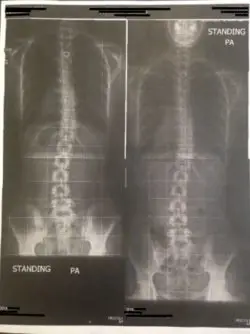This blog is part of the Analyzing Scoliosis series, which is designed to teach movement practitioners how to work confidently with clients with scoli. The first post discussed the typical scoli body. My book, Analyzing Scoliosis, which covers the topics in this series (as well as others) in more depth, is available on Amazon.
While there may be no typical scoliosis body, there are common types of scoliosis. If you can learn the characteristics of these common forms, chances are good that you’ll be able to work with almost any scoliosis client that comes your way.
More often than not, when people talk about scoli, Adolescent Idiopathic Scoliosis (AIS) is what they’re referring to. It’s extremely common—an estimated 2-3% of the population has it [1]. In fact, my guess is that most of the scoliosis clients you’ll see will have an AIS diagnosis. They will likely be female. Scoli affects more girls than boys, and the chasm between the two sexes becomes much wider with the increase of age and of curvature [2]. This also means females are more likely to have a more severe curve, and that likelihood increases as they get older.
What is an AIS diagnosis?
If scoliosis is found in someone between 10 and 18 years old, it is called adolescent scoliosis. In the medical world, “idiopathic” simply means the disease has no known cause. So, AIS is simply scoliosis that appeared in a person of a certain age and there was no obvious trigger.
Let’s be honest though—every curve has a cause. AIS is simply a descriptor of the current condition of someone’s spine, but obviously it doesn’t give any clues as to what actually caused the lateral curve in their spine (more information on potential causes of AIS can be found here).
What does AIS look like?
Characteristics of AIS include loss of spinal flexibility and rigidity [3]. You will also see muscle asymmetry in your AIS clients, but it’s important to note that the imbalances aren’t the cause of the scoli [4].
In addition, the spine usually takes the form of a backward letter “S,” with a curve in the thoracic spine going to the right and a curve in the lumbar spine going to the left. Sometimes there are a few extra curves below or above the main backwards “S.” The curves are accompanied by spinal rotation. I think of the vertebral rotation as a spiral, going up and down the whole spine, hence why I call it a “spiral spine.” However, even within AIS diagnoses, curves can present themselves in different ways with different people.
Since one of the curves is usually in the ribcage and there is spinal rotation, you’ll often see one side of the ribcage stick out further than the other on a client’s back. This is a widening of the space between the ribs. Often that widening is accompanied by bone remodeling where the vertebrae and ribs actually change shape slightly due to the uneven loading between the left and right sides of the body. The medical world refers to this as a “rib hump.”
Now that I’ve taught you that term, I have to add this side note—I cringe whenever I hear that phrase. Words are powerful, and too often these insensitive-sounding medical terms can negatively affect the person with scoli, whether they realize it or not. To lessen the emotional blow of talking about their condition, I simply refer to that part of their body as “the side that sticks out more in the back.” It may seem small and insignificant, but the way you phrase things can make a difference in your client’s perception of his or her own body.
How do you work with someone with AIS?
Clients with AIS need to move. Physical exercise is important during growth to delay or prevent the need for bracing and/or to keep the scoliosis under 30 degrees. Physical exercise will positively influence breathing function, strength, and postural balance, further helping your client.
Pilates is often perfect for people with AIS, and aligns well with how they need to move. To illustrate how great a fit it is, I’ll close with this anecdote:
A woman named “Sarah”, who had AIS, told me her doctors at the Mayo Clinic in Minnesota, arguably the most esteemed hospital in the world, said to “make Pilates her way of life” in order to treat her scoli.
If that isn’t a great endorsement for Pilates, I don’t know what is. I will pick up next time with another common type of scoli. In the meantime, I hope you’ll share your thoughts in the comments section.
Sources List
1 “National Scoliosis Foundation, Information and Support.” National Scoliosis Foundation, http://www.scoliosis.org/info.php. Accessed September 2017.
2 Konieczny, Marcus, Senyurt, Husseyin, and Krauspe, Rudiger. “Epidemiology of Adolescent Idiopathic Scoliosis.” Journal of Children’s Orthopaedics, vol. 7, no.1, 2013, pp. 3-9.
3 Hawes, Martha. “The Use of Exercises in the Treatment of Scoliosis: an Evidence-based Critical Review of the Literature.” Pediatric Rehabilitation, vol. 6, no. 3-4, 2003, pp. 171-182.
4 Azegami, H., Murachi, S., Kitoh, J., Ishida, Y., Kawakami, N., and Makino, M. “Etiology Of Idiopathic Scoliosis. Computational Study.” Clinical Orthopaedics and Related Research, vol. 357, 1998, pp. 229-236.
